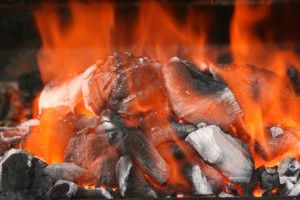
Not all regions of Russia are yet covered by the gas pipeline network, and for many residents heating the cottage with coal remains the only option. The use of cheap and affordable coal fuel is no longer associated with outdated ideas about it. Modern solid fuel boilers are easy to use, reliable and do not pollute the atmosphere with smoke. Our article will help you understand what features heating in a private house on coal has and what are its advantages.
Properties of coal as a fuel
Today, the safety of heating homes with coal has risen to a new level, and the operation of solid fuel boilers is no longer a hassle for homeowners, as it used to be. Even though the burning of any kind of coal for heating is frowned upon by environmentalists, its popularity is not decreasing, but only increasing.
The consumer qualities of coal for home heating compare favorably with the properties of other types of fuel:
- high heat transfer of coal provides more heat per unit of heated area;
- the use of solid fuel units allows you to arrange coal heating independent of the gas pipeline in a private house or cottage;
- to store coal, you do not need to install sealed tanks at home;
- coal, unlike firewood, is not afraid of dampness;
- convenient packaging makes it possible to transport purchased coal for heating both within the city and to the country house;
- the installation of boilers or stoves for solid fuels does not require a special permit, as is the case with gas heating.
Types of coal for heating
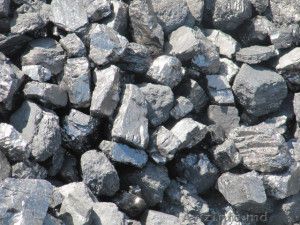
Commercially available coal for heating is divided into the following categories with letter designations:
- anthracite (BUT);
- long flame (D);
- long-flame gas (DG).
Classification by the size of the pieces of sorted coal:
- TO - large "fist" - 50-100 mm
- ABOUT - medium "nut" - 25-50 mm
- FROM - small "seed" - 10-25 mm
All types of coal for heating differ in different degrees of heat transfer, and during combustion they form an unequal amount of by-products. In particular, the combustion of gaseous coal and long-flame coal is accompanied by a large release of furnace gas and smoke. Anthracite, on the other hand, contains a more significant percentage of carbon, burns almost without smoke, and after its combustion there is little ash and slag.
Which of the grades of this fuel is better? How much coal does it take to heat a house to last until spring? Among consumers using coal heating, reviews confirm the opinion that anthracite "nut" is considered the best coal. For the heating season, it needs much less weight than other varieties. Therefore, the cost of anthracite is twice as high as that of long-flame.
It should be mentioned that high-quality coal packaged in bags is more expensive than the one sold in bulk. The difference is that there is no dust in the packaged coal that interferes with normal combustion. In addition, when coal is sold in bags, its real weight can be more accurately controlled.
Since the slag after the combustion of coal has to be disposed of somewhere, one of the options may be the manufacture of cinder blocks for the construction of outbuildings.
Coal heating equipment
Coal stoves
An ordinary stove can only heat one or two rooms, even if you use coal instead of wood to heat the house. True, it can be improved by embedding a heat exchanger for water heating inside the brickwork. The stove is good in its own way, but sometimes it can be dangerous due to the fact that it provokes carbon monoxide poisoning.
Important. The chimney damper can be closed only after the coal has completely burned out and the flames disappear from the firebox.
For heating a cottage with coal, a heating unit such as a boiler is much more efficient, reliable and safe.
Coal solid fuel heating boilers
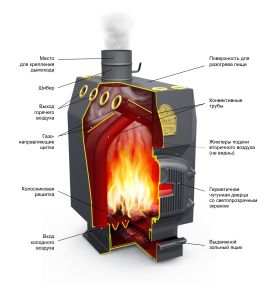
By design, a coal-fired heating boiler is simple, but very effective. Its cast iron heat exchanger and powerful grate are resistant to burnout and corrosion. Even the simplest of these devices have been regularly heating homes for many decades. But still, old-style boilers are inferior in performance and heat transfer to their current competitors.
The principle of operation of a heating boiler looks like this:
- as soon as a fire is lit in the firebox, a draft is created in the chimney and air is drawn into the fuel chamber;
- the coal is heated and partially burned;
- the gaseous products of coal combustion are mixed with the secondary air supplied inside and finally burned;
- the resulting gases give their temperature to the coolant, and then are removed through the chimney.
Modern coal-fired heating boilers steadily heat living quarters and outbuildings. They consume 2 times less fuel compared to outdated models. Advanced technologies have improved not only the construction and design of heating units, but also the very principle of fuel combustion. As a result, the homeowner no longer has to load another batch of coal into the boiler several times a day and remove the accumulated slag.
The enlarged combustion chamber is designed for a one-time loading of a large amount of coal, which gradually burns out over 6-12 hours. Forced air blowing contributes to the most complete combustion of fuel. Thanks to this, the consumption of coal for heating the house is noticeably reduced.
Especially for automatic models of heating equipment, it is recommended to purchase eco-pea coal, which has optimal dimensions and is free from dust impurities.
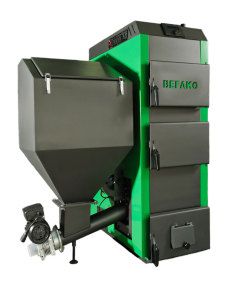
The automated supply of fuel from the bunker to the boiler "frees the hands" of the user. He becomes free from the obligation to constantly monitor the operating heater. The hopper has enough capacity for non-stop coal burning for a week.
Reviews of coal heating demonstrate how satisfied users are with the practicality of automated coal boilers. This is very convenient - at the beginning of the heating season, start up the boiler, and all winter only add coal to the hopper as it is emptied. It is also not necessary to remove ash and slag too often, only a couple of times a month.
Lighting coal for heating in a boiler, especially anthracite, can be difficult for an unaccustomed person. First, the boiler is fired with wood or a special mixture, and then little by little coal is added. When the combustion becomes stable, you can fill in anthracite in large portions. How much and how often will depend on the boiler model and will be more precisely determined in the practice of its use.
Do not use gasoline to ignite coal in a heating boiler!
But what if the electricity goes out in the house? In this case, the automatic supply of coal to the boiler fuel chamber will stop.At the same time, the circulation pump will stop working and water will stagnate in the heat exchanger. But the boiler will not boil, because coal combustion will go into a weak mode. Then, when the power supply is restored, the coal will ignite again.
Maintenance of a solid fuel boiler
Boiler maintenance measures are reduced to the need to clean the heat exchanger and flue ducts. Soot settles on their surfaces, and this phenomenon reduces the efficiency of the heating unit by 15%. The frequency of cleaning the coal heating boiler can vary: old cast iron models have to be cleaned 2-3 times per season, and modern ones once every 2 years.
For unimpeded maintenance of the boiler, there must be free access to it in the room where it is installed.
Calculation of the power of a coal boiler for heating a house
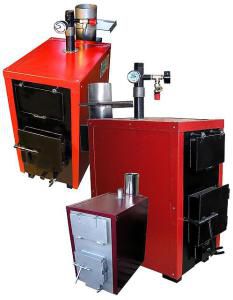
The power of a water heating boiler is one of the most important indicators of the operation of the entire heating system. Although most modern solid fuel boilers give an efficiency of at least 80-90%, still not every model is able to cope with heating a significant volume of premises. The average annual consumption of coal for heating a house also depends on the power of the heating unit. A specialist who will take into account the average temperatures in the region and the area of the heated house will be able to calculate the boiler power required in specific conditions.
You can choose the power of the boiler when buying it according to the following rule: to heat 100 m² of a residential building, you need 10 kW of heat energy per hour.
For example, to heat a country house with an area of 200-250 m² (plus a pool and a garage), a 40 kW boiler will be enough. An error in the choice of power can further adversely affect the consumption of coal for heating the house and the comfort of heating. With insufficient power, it will be cold in the premises, and with excessive power, it will result in excessive fuel consumption.
Calculation of coal consumption for the heating season
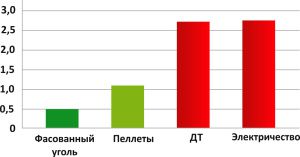
Engineers have calculated that to obtain 10 kW of thermal energy, 2 kg of coal must be burned. However, preliminary calculations of how much coal is needed to heat a house may turn out to be inaccurate. The real fuel consumption will become clear only after the end of the heating season. The error arises due to the influence of many factors: the type of coal for heating, the climatic zone, the location of the house, the insulation of the walls, the number of windows, etc.
Reviews of their homes using coal heating indicate that when the temperature outside is above freezing, they burn 1 bucket of coal a day on average. In cold weather - 2-3 buckets, and in severe cold you have to heat the house with 10 buckets of coal per day. You just need to look, they clarify, that it is good coal, and not waste rock and not dust.
According to the experience of homeowners, heating a 65 m² house in the Volgograd Region requires 4 tons of coal to heat a house. And the owner of a house with an area of 200 m² in the Middle Urals, where frosts are below 30 degrees, has to store up a whole "Kamaz" of anthracite for the winter.
When calculating how much coal is needed to heat a house, keep in mind that brown coal has the lowest heat transfer, and anthracite has the highest.
On the proposed video, you can familiarize yourself with the methods of using a solid fuel boiler in a heating system.
At the present time, when natural gas and oil products dominate the energy market, heating your own cottage with coal in no way loses its relevance. We hope that after reading our article, you have learned how to arrange heating in a private house on coal. And now, having enriched with theoretical knowledge, you can start translating them into reality at home.







